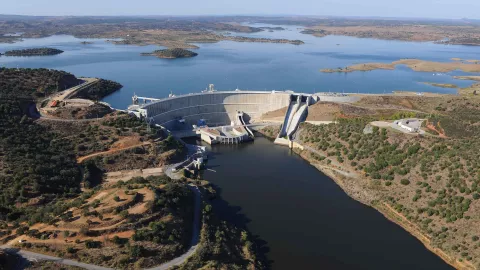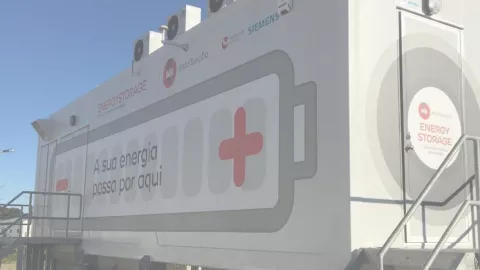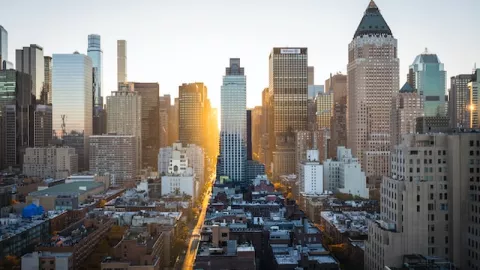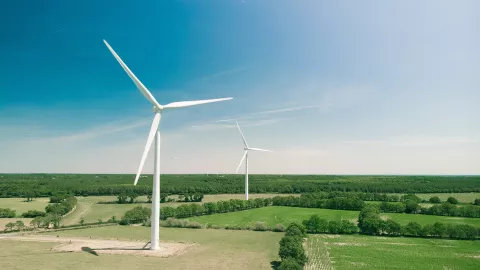Greater flexibility for an electrical future
Imagine yourself at a yoga class. Stay upright with your legs well stretched. Lift your arms towards the ceiling while breathing in deeply. Then breathe out slowly and flex your body forward, without bending your legs, until you touch your feet with your hands. Repeat until you can feel that your body is being pushed to its limits and you'll feel increasingly flexible. So flexible that sooner or later you will easily put one leg behind your back. This is one of the most classic yoga poses for improving your flexibility. It is thanks to persistence and resolve that you will achieve undreamed-of positions.
Now transpose this exercise to your energy consumption at home. Imagine that you have a range of renewable energy solutions, such as photovoltaic solar panels, to make sure that all the electricity you consume is 100% renewable - and available whenever you need it. This is what we call the energy sector's flexibility, or, if you prefer, the yoga of your home - providing all the energy you need, wherever and whenever you need it.
In the words of the Director of EDP's Energy Management Business Unit Pedro Neves Ferreira, “such flexibility will become increasingly necessary in the energy sector, with the growing penetration of renewable energies, especially wind and solar energies, which are experiencing very significant growth.”
Goodbye fossil fuels, hello electrification
EDP Energy Planning Director Ana Quelhas gives us some insights into the future of the energy sector. “If electricity today accounts for about one-fourth of the energy we consume, by 2050 this ratio is expected to be two-thirds, which represents a radical change in the way we consume energy. In transport, industry and buildings, the path to take is that of electrification, so that we can contribute to energy efficiency and to reducing emissions.” This ambitious yet increasingly possible sentence sets the tone for the profound change the energy sector is experiencing, in which decarbonization plays a key role. This means, on the one hand, gradually abandoning fossil fuels and, on the other, adopting sustainable alternatives and investing in the electrification of consumption - two trends that have been gaining traction around the world for some time.

“If electricity today accounts for about one-fourth of the energy we consume, by 2050 this ratio is expected to be two-thirds, which represents a radical change in the way we consume energy. In transport, industry and buildings, the path to take is that of electrification, so that we can contribute to energy efficiency and to reducing emissions.” Ana Quelhas, EDP Energy Planning Director
The unpredictability and volatility of renewable energies
Although we do not control the wind or the sun - two important renewable energy sources, wind and solar photovoltaic -, the flexibility of the sector, regardless of such volatility, is now beginning to take large strides both domestically and internationally But what does greater flexibility mean?
Such flexibility is the magic of instant energy response whenever we need it - but in this case, solely with renewable energy solutions, in which EDPR is the world leader. But it turns out that this transition may not be as flexible as it seems. “We will do without thermal power plants and replace them with wind and solar farms - which are rebellious and highly volatile energy sources. While thermal power plants succeeded in matching production to consumption on a millisecond timescale, with perfect synchrony, renewable sources, because they are uncontrollable, cannot reassure us with such synchrony,” says Pedro Neves Ferreira. Nonetheless, figures show that the share of renewable sources in the energy production mix has been growing, as can be seen in the table below.


EDP Comercial Director António José Coutinho describes the complexity of this transition in other words: “Electricity is a very special, almost magical asset. When we plug in a power outlet, when we turn on a switch, there is an instant energy response. Production always depends on consumption. Once we switch completely to renewable sources, we will not be able to know, today, at two in the afternoon, if tomorrow's energy production will be sufficient. And this is where flexibility comes in automatically: water need only be hot when it is needed. Almost perfect adjustments are made with water storage, but this is not enough. We need a range of technologies, services and business models which explore consumption flexibility. And this is where digitalization plays a crucial role, as it makes it possible to manage that flexibility and develop the services companies need to meet customer needs, in tune with the system itself.”
You can't control the wind in Portugal, but you can adjust the storage
The need for greater flexibility arises from the articulation of production and demand. How? “On the one hand, with more interconnected European networks, so as to make it possible to distribute the volatility of renewable sources across more regions and countries. On the other hand, with storage, the so-called batteries, so that we can use stored energy when production decreases but there is consumption,” says Pedro Neves Ferreira. EDP Energy Planning Director Ana Quelhas adds that “Portugal is very well positioned in terms of water storage capacity because of our many reservoirs, through pumping, making it possible to channel excess energy to where it is needed.”
It was in this context that the Iberian Electricity Market (MIBEL), now fully established, was created back in 2007 as part of Portugal and Spain's cooperation effort to integrate the two countries' electrical systems. And now, with their eyes set on the future, the two countries are increasingly embracing renewable alternatives.
Competitive and socially responsible energy
As the weight of renewable sources increases - as part of the effort to gradually reduce the use of fossil fuels - the sector faces highly complex challenges, such as the redefinition of the market itself. The more renewable energies we have in the system, the more wholesale market prices will drop. However, the lower market prices get, the harder it will be to recoup the investment. If fossil fuels, such as coal and gas, have a cost - the raw material itself -, renewable sources, although free, require an initial investment in production technology and infrastructure: “In a sense, this has to do with the way the wholesale market was designed, in that we have different prices for each hour (8,760 hours per year), which creates permanent - that is, variable - hourly competition. With this new system prices will no longer be variable, we will only have the initial, fixed investment costs. The nature of these costs has changed, which forces us to rethink the way the market operates,” says Pedro Neves Ferreira.
And consumption is also very inflexible here. “But it will be possible to make it a little more flexible, especially when it comes consumptions associated with some thermal inertia or electric vehicles, which requires a very smart network and an increasingly present digitalization in our lives,” Pedro Neves Ferreira adds.
In the words of Ana Quelhas, “in order to make sure that supply always matches consumption, we must have very innovative technologies. Endowing the system with this flexibility, which includes hydroelectric plants, interconnections with Spain, and major innovations on the supply side, must be complemented by other technologies so that we can meet these consumption demands instantly.”
In short, integrating renewable energies in a competitive and socially responsible manner is the priority for a greener world, over a short/medium-term horizon.
The active role of citizens
“Decarbonization entails electrification, but let us not forget that electricity accounts for only 22% of our overall energy consumption. To achieve full decarbonization we must electrify the remaining energy.” António José Coutinho further states that this complex energy transition process begins with customers: “Citizens will have a more active role in this process, but companies must be smart enough to develop solutions that meet customer needs and are easy for them to adopt.”
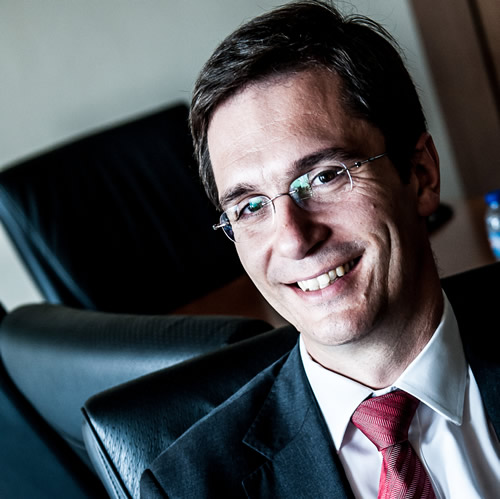
“Citizens will have a more active role in this process, but companies must be smart enough to develop solutions that meet customer needs and are easy for them to adopt,” António José Coutinho, EDP Comercial Director
Customers are part of the solution
The problem is the initial cost of these sustainable solutions, which is high, although it is an investment with a medium-term return. “Consumers usually don't make this initial investment, because it takes about seven years to get a return, which is a very long period for most customers. But it should be pointed out that when we electrify our energy consumption, our consumption needs decrease three- to fourfold. People are also increasingly sensitive to sustainability issues and it's up to us to address that, through our business, the regulator, and pressure from society itself, so that customers become part of the solution,” says António José Coutinho.
To achieve this there is a very close and open dialogue with customers. “We do face-to-face co-creation sessions with customers, who help us understand the problem and how they would solve it. Then we do another session with these same customers to present the solutions we have come up with based on the inputs from the first session, we iterate, and we close the solution. After arriving at a solution based on the consumer's inputs, we start testing the product directly on the market - before we have even developed it - to see if the market responds positively.”
For instance, this was how EDP's 'Electric Mobility Solutions' and the 'https://www.edp.pt/particulares/servicos/casa-eletrica/ solution for the Portuguese market were born - from a sample of customers who used gas to heat their homes, cook meals, and shower. Together with these customers we came up with a service in which we installed sustainable alternatives in consumers' homes, with an easy payment plan that pays for itself in the medium term,” António José Coutinho adds.
Mobility is one of the roads to greater flexibility
The growing presence of electric cars on the road is a good example in this equation. When you buy an electric vehicle, you stop consuming only fossil energy sources and start adding more and more renewable energy to your mix. “But we have to be more ambitious in transport. First, greater adoption of electric vehicles by individuals and companies. And then we must also electrify the entire public transport system. In Portugal, the Government decided, rightly so, to electrify the entire railway system and the ferries crossing the Tagus river in Lisbon. But we have to add the bus fleet and we are not doing that. There are 450,000 electric buses operating in China and only 2,000 in Europe. City halls must also be more demanding regarding companies' fleets, for example. And there is no valid reason why taxis should not all be electric. There must be greater government regulation,” says the EDP Comercial director.
EDP = mobility + flexibility
EDP provides a range of solutions to encourage the growing adoption of these technologies in this field. “What EDP is doing to propel the electrification of consumption, decentralization and digitalization is to promote electric mobility so that residential buildings and homes can charge their residents' cars, for example. Most cars are not moving 90% of the time, and when this happens they can be connected to the grid; and in a few years they will consume or transfer the energy which they need or do not need,” says António José Coutinho. And all this is done digitally. “The system is able to tell me if I have too much energy so that I can transfer it automatically to cars with low battery power. All these technologies have a higher initial cost but a lower cost in the future,” says the EDP Comercial director.
An assumed commitment
"Portugal reaffirms its firm commitment to achieving greenhouse gas emissions neutrality by the end of the first half of the century." These words were uttered by Portuguese Prime Minister António Costa and are included in the 2030 National Energy and Climate Plan report.
António José Coutinho replies that “EDP agrees and undertakes this commitment to consumption electrification, with the promise that it will continue installing renewable [infrastructure]. And we must not forget that EDP is the fourth-largest renewable energies operator in the world.”
The EDP group has undertaken, over a decade ago, with more than 20 GW of installed renewable capacity contributing to 66% of our production. 2020 marks the start of a decade that will be decisive to achieving carbon neutrality in 2050 and accelerating the profound behavioral changes this requires. Acknowledging this urgency, EDP has joined other companies in the sector to ask the European Union to set the goal of achieving carbon neutrality by 2050 and to raise the 2030 GHG emissions reduction goal to at least 55% (compared to 1990).
What is being done under the motto 'Clean Energy'
As such, EDP has already carved out a successful path in Portugal, boasting a production mix with 66% from renewable sources: 45% wind, 21% hydro, 15% gas, and 16% coal. But Portugal - the 5th country with the highest renewable energy/energy mix ratio - is not alone in this path, as the graph below shows.
The IEA's current strategy is summed up in the motto 'Clean Energy', which is based on the sector's decarbonization, energy efficiency, the development of competitive and efficient technologies focusing on renewable energies for electricity and heat production, as well as energy storage and smart electricity grids. Accordingly, it was decided in the aftermath of the Paris Agreement to adopt all the necessary measures to limit the global temperature increase to 1.5ºC by the end of the 21st century and to create the 'Mission Innovation' voluntary program, which most member countries (and other nations) have already joined.
Thus, in order to make the green road a common path, all EU institutions made a commitment in late 2018 to tackle climate change and fight for a clean energy future, with the goal of building a safe, competitive and low-carbon Europe. This is a directive published in late 2018 in the Official Journal of the European Union, titled 'Clean Energy Package', containing the goals for 2030 and 2050.
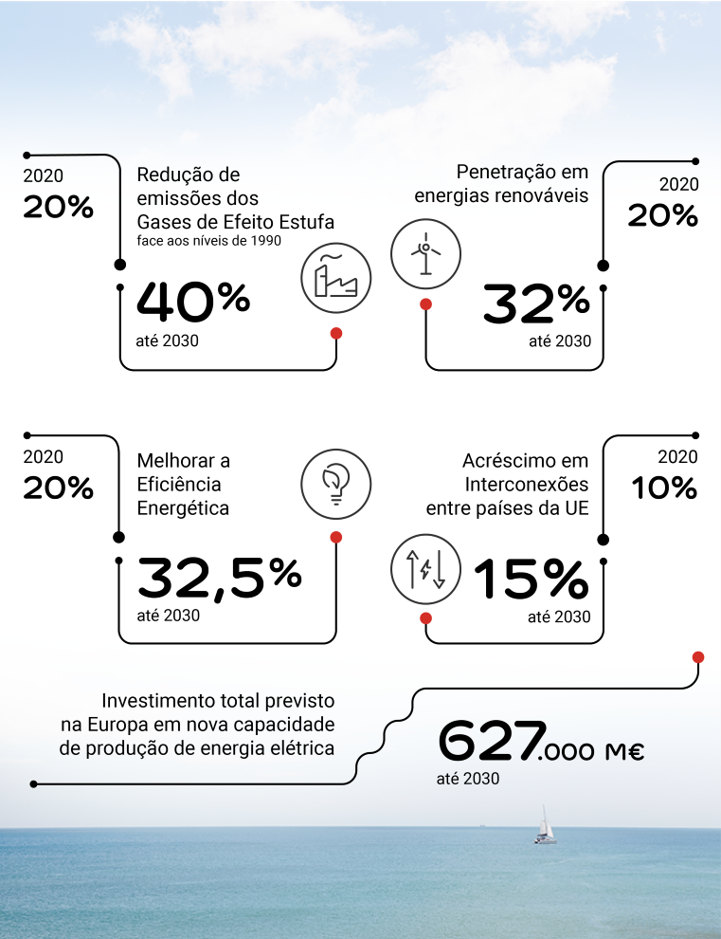

A leader called EDP - with three Ds
This is the future we are building and EDP has been able to anticipate it and maintain its leadership position by driving a revolution based on three pillars: decarbonization, decentralization, and digitalization. And efficient energy storage is the key for opening the door to this future.
Digitalization, which has been having a huge impact on all sectors, and which has caused profound disruptions in more traditional business models, is the piece that will link all these components, allowing for more efficiency on both the supply and demand side. We are thus moving towards an energy internet in which everything will be connected and just a click away.
Finally, since energy is at the center of everything, choices must be made collectively and society will continue to demand absolute transparency in the way we operate. The energy sector will have an increasingly crucial role in the development of a just and balanced society.
